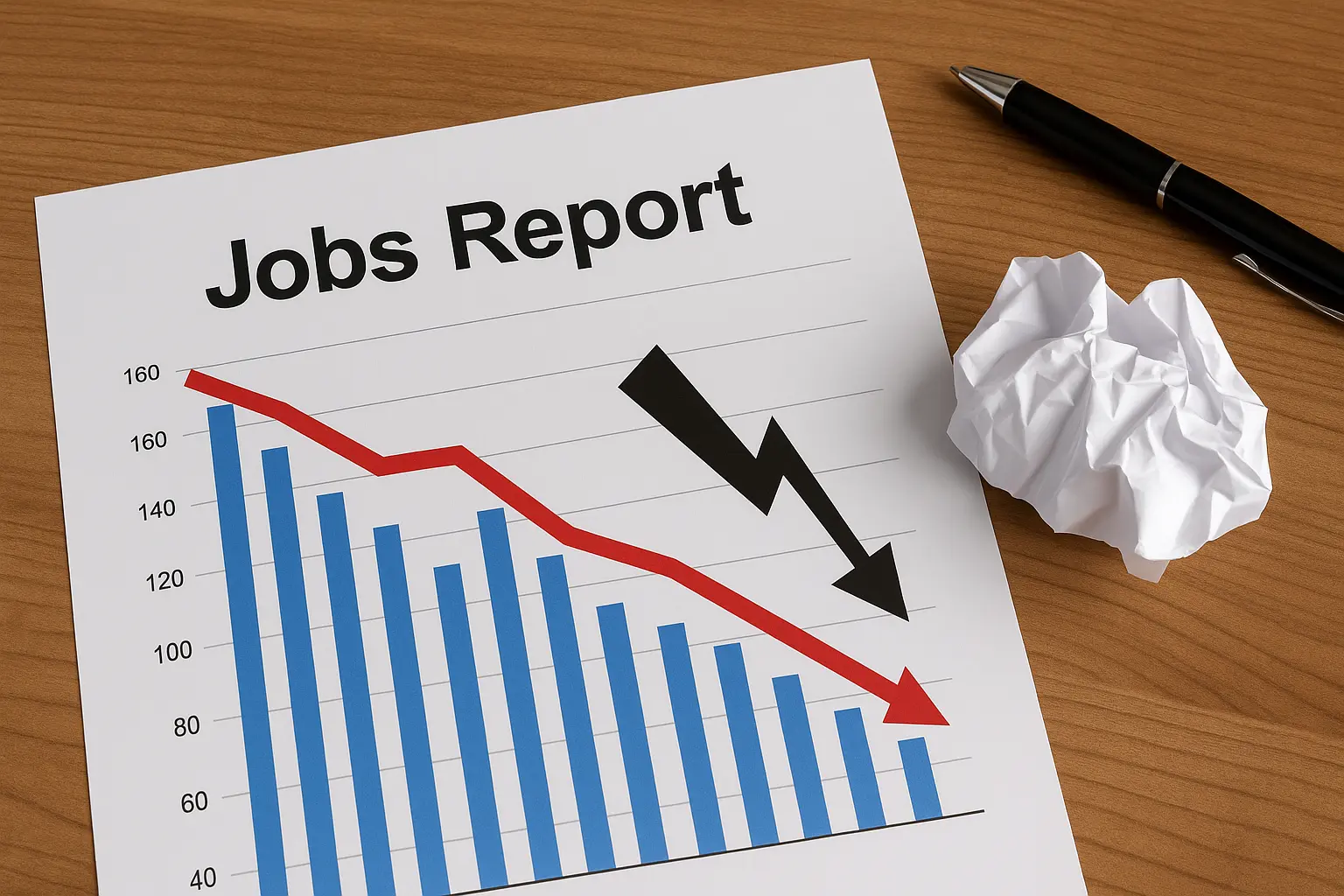The Shocking July Jobs Report: Labor Market Weakening Revealed
The shocking July jobs report has sent shockwaves through financial markets and economic analysts, revealing a labor market that’s significantly weaker than previously believed. With only 73,000 jobs added in July—far below the expected 100,000—and massive downward revisions to May and June data, the employment landscape is showing concerning signs of deterioration that could signal broader economic challenges ahead.
The Federal Reserve’s confidence in a strong labor market has been shaken by these revelations, as the unemployment rate crept up to 4.2% and job growth appears to be concentrated in fewer sectors than previously thought. This shocking July jobs report labor market weakening represents a critical turning point in our understanding of the current economic recovery and raises important questions about the sustainability of recent growth patterns.
The Devastating Reality Behind the Numbers
The shocking July jobs report labor market weakening becomes even more concerning when we examine the massive revisions to previous months’ data. May’s job numbers were revised down by 125,000 positions, while June’s figures were slashed by 133,000 jobs. These revisions, totaling 275,000 fewer jobs than originally reported, paint a picture of an employment market that was never as robust as policymakers and analysts believed.
This revelation is particularly troubling because the Federal Reserve has been relying on strong labor market data to justify its current monetary policy stance. The shocking July jobs report labor market weakening now calls into question the central bank’s assessment of economic conditions and may force a reassessment of interest rate policy in the coming months.
The concentration of job growth in healthcare and social assistance sectors, while manufacturing and industrial production remain flat, suggests that the economic recovery is becoming increasingly narrow and potentially unsustainable. This pattern of the shocking July jobs report labor market weakening indicates that the broader economy may not be as healthy as recent headlines suggested.
Sector Analysis: Where Jobs Are and Aren’t Growing
The shocking July jobs report labor market weakening reveals a concerning trend in job distribution across different sectors. Healthcare and social assistance continue to dominate employment growth, with positions for physician assistants and in-home care providers leading the way. However, this concentration creates vulnerability in the labor market, as it relies heavily on a single sector for job creation.
Manufacturing, industrial production, retail, and professional services all showed minimal growth or stagnation, according to the shocking July jobs report labor market weakening data. This lack of diversification in job creation is particularly concerning given the current economic environment and the potential impact of ongoing trade tensions and technological disruption.
The shocking July jobs report labor market weakening also highlights the growing disconnect between high-end talent demand and middle-market employment opportunities. While companies like Microsoft continue to pay premium salaries for specialized skills, middle-tier positions are experiencing increasing pressure, with some companies beginning to implement smaller layoffs that could accumulate over time.
Wage Growth and Inflation Dynamics
Despite the shocking July jobs report labor market weakening, wage growth has remained relatively stable, with a 0.3% month-over-month increase and approximately 3% annual growth. This wage growth is currently outpacing inflation, providing some relief to employed workers. However, the sustainability of this trend is questionable given the broader economic indicators.
The shocking July jobs report labor market weakening suggests that while current workers may be experiencing modest real wage gains, the overall employment environment is becoming more challenging for job seekers and those looking to advance their careers. This creates a paradox where employed workers are doing relatively well, but the labor market is becoming less accessible for new entrants.
The Federal Reserve will need to carefully consider these wage dynamics when evaluating the shocking July jobs report labor market weakening data. While wage growth remains positive, the overall employment picture suggests that inflationary pressures may be moderating, which could influence future monetary policy decisions.
Federal Reserve Policy Implications
The shocking July jobs report labor market weakening has significant implications for Federal Reserve policy in the coming months. Fed Chair Jerome Powell and the Federal Open Market Committee have consistently cited strong labor market conditions as a key factor in their monetary policy decisions. This new data may force a reassessment of their economic outlook.
The shocking July jobs report labor market weakening, combined with the upward creep in the unemployment rate to 4.2%, suggests that the Fed may need to consider more accommodative monetary policy sooner than previously anticipated. Market expectations are now pointing toward potential rate cuts in the coming months, with September, October, and December meetings all being viewed as possible venues for policy easing.
The Federal Reserve’s next meeting, scheduled for 47 days from the report’s release, will be crucial in determining how policymakers interpret the shocking July jobs report labor market weakening and what actions they take in response. The central bank must balance concerns about economic slowing with its mandate to maintain price stability.
Immigration and Labor Force Participation
The shocking July jobs report labor market weakening also highlights the impact of immigration policy on employment dynamics. Reduced immigration levels have contributed to fewer people applying for jobs, which affects both the unemployment rate calculation and the overall labor force participation rate.
This demographic factor in the shocking July jobs report labor market weakening creates additional challenges for employers seeking to fill positions, particularly in sectors that have traditionally relied on immigrant labor. The combination of reduced immigration and weakening job growth creates a complex employment landscape that may require policy adjustments.
The shocking July jobs report labor market weakening suggests that immigration policy changes may be having a more significant impact on labor market dynamics than previously recognized. This factor adds another layer of complexity to the Federal Reserve’s policy considerations and the broader economic outlook.
Consumer Confidence and Economic Sentiment
The shocking July jobs report labor market weakening is likely to impact consumer confidence and economic sentiment in the coming weeks. Consumer confidence data, which was scheduled for release shortly after the jobs report, will provide important insights into how households are perceiving the economic environment.
The shocking July jobs report labor market weakening may cause consumers to become more cautious about their spending and employment decisions. This could have ripple effects throughout the economy, affecting everything from retail sales to housing markets to investment decisions.
Looking to Hire Fast?
Hiring managers can now post jobs for free on WhatJobs and connect with millions of jobseekers.
👉 Post a Job Now →The relationship between the shocking July jobs report labor market weakening and consumer behavior is crucial for understanding the broader economic trajectory. If consumers become more pessimistic about employment prospects, this could further slow economic growth and create a self-reinforcing cycle of economic weakness.
Market Reactions and Investor Implications
Financial markets reacted immediately to the shocking July jobs report labor market weakening, with bond yields falling and equity markets showing increased volatility. Investors are now pricing in a higher probability of Federal Reserve rate cuts in the coming months, reflecting the market’s interpretation of the employment data.
The shocking July jobs report labor market weakening has also affected expectations for corporate earnings and economic growth. Companies may need to adjust their hiring plans and growth projections based on the new employment reality, which could impact stock valuations and investment strategies.
For individual investors, the shocking July jobs report labor market weakening suggests the need for more defensive positioning in portfolios, with increased focus on sectors that may be less sensitive to economic slowing. This could include healthcare, utilities, and consumer staples, which tend to perform better during economic uncertainty.
Policy Recommendations and Economic Outlook
Based on the shocking July jobs report labor market weakening, economic policymakers may need to consider several adjustments to their current approach. The Federal Reserve may need to signal a more dovish monetary policy stance, while fiscal policymakers may need to evaluate whether additional stimulus measures are warranted.
The shocking July jobs report labor market weakening also suggests that trade policy and immigration reform may need to be reconsidered in light of their impact on employment dynamics. The concentration of job growth in healthcare and social assistance, combined with weakness in manufacturing and industrial sectors, indicates that current policies may not be achieving their intended economic objectives.
For individual workers and job seekers, the shocking July jobs report labor market weakening underscores the importance of maintaining current employment while building skills that are in demand. The healthcare and social assistance sectors continue to show strength, while other sectors face increasing challenges.
The Path Forward: Economic Recovery or Further Weakening?
The shocking July jobs report labor market weakening raises critical questions about the sustainability of the current economic recovery. While some sectors continue to show strength, the overall employment picture suggests that the economy may be entering a period of slower growth or potential contraction.
The Federal Reserve’s response to the shocking July jobs report labor market weakening will be crucial in determining whether this represents a temporary slowdown or the beginning of a more significant economic downturn. The central bank’s ability to provide appropriate monetary stimulus while maintaining price stability will be tested in the coming months.
For businesses and workers alike, the shocking July jobs report labor market weakening serves as a wake-up call to prepare for potentially more challenging economic conditions. This may include building financial reserves, developing new skills, and positioning for opportunities in sectors that continue to show strength.
The shocking July jobs report labor market weakening represents a significant turning point in our understanding of the current economic environment. With only 73,000 jobs added in July and massive downward revisions to previous months’ data, the employment landscape is clearly weaker than previously believed. This development has important implications for Federal Reserve policy, consumer confidence, and the broader economic outlook.
As we move forward, it will be crucial to monitor how policymakers respond to the shocking July jobs report labor market weakening and whether additional economic data confirms this trend. The coming months will likely see increased volatility in financial markets and potentially significant changes in monetary policy as the Federal Reserve adjusts to the new economic reality.
Frequently Asked Questions
Q: How does the shocking July jobs report labor market weakening affect Federal Reserve policy?
A: The shocking July jobs report labor market weakening has significant implications for Federal Reserve policy, as the central bank has relied on strong labor market data to justify its current monetary stance. The weak employment numbers may force the Fed to consider more accommodative policy, including potential rate cuts in the coming months.
Q: What sectors are most affected by the shocking July jobs report labor market weakening?
A: The shocking July jobs report labor market weakening shows that manufacturing, industrial production, retail, and professional services are experiencing minimal growth or stagnation. Job creation is increasingly concentrated in healthcare and social assistance, creating vulnerability in the broader labor market.
Q: How should workers respond to the shocking July jobs report labor market weakening?
A: Workers should focus on securing their current employment while building skills in high-demand sectors like healthcare and social assistance. The shocking July jobs report labor market weakening suggests that job security and skill development are more important than ever in the current economic environment.
Q: What does the shocking July jobs report labor market weakening mean for the broader economy?
A: The shocking July jobs report labor market weakening indicates that the economic recovery may be less robust than previously believed. This could lead to slower economic growth, increased Federal Reserve intervention, and potentially more challenging conditions for businesses and workers in the coming months.




